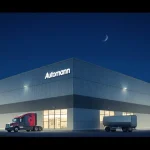Proponents advocate RNG as the most sustainable fuel for trucking

As the transportation sector grapples with the urgent need for sustainability, renewable natural gas (RNG) is emerging as a frontrunner among alternative fuels. Advocates for this eco-friendly option gathered at the American Trucking Associations’ Management Conference & Exhibition to discuss its potential and share insights on its growing role in the industry.
With California leading the charge due to its stringent environmental regulations, RNG is gaining traction across the United States. The conference, hosted in vibrant San Diego, featured a panel moderated by Daniel Gage, president of the Transport Project, which tackled common concerns regarding RNG's performance, range, and fueling infrastructure.
Understanding renewable natural gas: what is it?
Renewable natural gas is a purified biofuel generated from organic waste, such as:
- Landfills
- Wastewater treatment plants
- Animal manure
This green fuel not only repurposes waste but also contributes to a significant reduction in greenhouse gas emissions. By utilizing RNG, the transportation sector can substantially lower its carbon footprint, a crucial objective in today's climate-conscious environment.
Current landscape of RNG in the trucking industry
The adoption of RNG is on the rise, with over 100,000 heavy-duty vehicles currently utilizing this fuel across the nation. Eric Bippus, chief commercial officer of Hexagon Agility, affirmed that while diesel is still the predominant fuel in trucking, RNG has proven itself as a viable and sustainable alternative.
According to the Transport Project, using RNG can lead to an impressive 300% reduction in emissions, achieving negative carbon-intensity outcomes while simultaneously lowering fuel costs. This dual benefit makes RNG a compelling choice for fleet operators seeking to enhance their sustainability efforts.
Performance and efficiency of RNG vehicles
Leading companies like J.B. Hunt Transport Services are integrating natural gas into their operations, aiming for a 32% reduction in carbon emission intensity by 2034 compared to 2019 levels. Jerrod Mounce, the vice president of energy and sustainability at J.B. Hunt, praised the performance of the Cummins X15N engine, the first 15-liter natural gas engine designed for heavy-duty trucks.
Key specifications of the Cummins X15N include:
- Power ratings of up to 500 hp
- Torque up to 1850 lb.-ft.
- A range of 750 miles (1,200 km)
- A 10% increase in efficiency compared to the Cummins ISX12N
Mounce pointed out that while maintenance costs for natural gas trucks are slightly higher than for traditional diesel trucks, the overall benefits and efficiency gains make them a worthy investment.
Challenges and misconceptions in adopting RNG
Despite its advantages, the transition to RNG vehicles has encountered some roadblocks. Initial skepticism among drivers regarding the technology's safety and performance has been notable. Mounce noted that concerns often stem from the large gas tanks mounted on the vehicles, leading to misconceptions about their safety.
To foster broader acceptance, the passage of federal legislation providing a $1-a-gallon tax credit for RNG use could significantly ease the apprehension surrounding this fuel type, boosting its adoption across the trucking industry.
Infrastructure growth supporting RNG fuel
The infrastructure for RNG is expanding rapidly, with Marc Rowe, director of sales at Love’s Alternative Energy, revealing that more than 500 facilities are currently producing RNG. This number is projected to double before the end of the decade. As of now, approximately 1,500 natural gas fueling stations are operational in the U.S., with about half specifically catering to heavy-duty vehicles.
Innovations driving the future of RNG
Technological advancements in RNG are paving the way for a more sustainable future. Barr from Cummins highlighted how real-world feedback from fleets using earlier generations of natural gas engines has informed crucial design improvements, such as switching from aluminum to steel pistons to enhance durability.
At the conference, Clean Energy Fuels Corp showcased a 2026 Freightliner Cascadia day cab equipped with the Cummins X15N engine, demonstrating the commitment to integrating RNG into modern trucking solutions.
In a recent announcement, Clean Energy secured several new RNG agreements, including a significant partnership with Paper Transport, which will utilize 250,000 gallons of RNG annually to fuel 12 new trucks. This collaboration emphasizes the versatility of RNG and the growing demand for clean fuel alternatives that do not compromise performance.
For more insights on RNG in trucking, check out this informative video that explores the future of renewable natural gas as a truck fuel:
As the push for sustainability continues, RNG stands out as a transformative option for the trucking industry, simultaneously addressing environmental concerns and operational efficiency. Its growth will depend on continued investment in technology, infrastructure, and education to alleviate misconceptions and encourage widespread adoption.




Leave a Reply